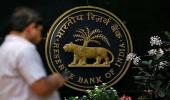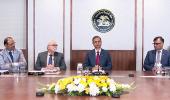'Deposit and lending rates have started to fall considerably. It is likely to spur investment and consumption of durables.'

Nagesh Kumar, an external member of the Reserve Bank of India's (RBI's) Monetary Policy Committee (MPC), says in an interview with Manojit Saha/Business Standard that if inflation stays at around 3 per cent, there would be additional room to manoeuvre, assuming a real interest rate of around 1.5 per cent.
The market was expecting a 25-basis point (bp) cut in the policy repo rate, but the MPC has surprised with a 50-bp reduction. What was the reason behind it?
Since the February 2025 MPC, the RBI has started to support growth by cutting policy rates.
The repo rate has been cut by 50 bps in two instalments, besides a massive liquidity expansion.
The monetary policy stance was also changed to accommodative in April 2025.
However, the transmission of the monetary easing has been slow or moderate, as reflected by the sticky deposit and lending rates, and credit growth has been moderate.
In the April MPC, I had argued that a 50-bp cut at one go may be more effective than two cuts of 25 bps each.
In view of difficult external circumstances requiring support for economic growth, and a favourable inflation outlook providing headroom for further rate cuts, the case for a 50-bp cut in the repo rate had become stronger at the June MPC meeting and hence received wide support.
A double dose of rate cuts has already demonstrated quick transmission, and deposit and lending rates have started to fall considerably. Hence, it is likely to spur investment and consumption of durables.

What was the reason for changing the stance to neutral?
At the time of the June MPC meeting, the inflation outlook seemed very benign.
Retail inflation in April 2025 had slowed down to 3.2 per cent, its lowest level in 69 months.
Given the softening of commodity prices, especially crude oil to around $65 per barrel compared to around $75 per barrel earlier, predictions of a good or above average monsoon, and a soft dollar, all indicated that the inflation outlook would continue to remain sub 4 per cent in 2025–26.
Inflationary expectations also remained well anchored, according to RBI surveys.
The May 2025 inflation figures were even lower than those in April. However, since the June 4–6 meeting, the Israel–Iran conflict has affected the outlook for inflation, with rising crude oil prices.
One has to wait and watch how the situation plays out. In such circumstances, it is good to have a neutral stance as it provides the flexibility to move up or down.
Do you see scope for further easing of the monetary policy?
The future rate cuts and their extent will be determined by the growth–inflation dynamics as it evolves in the coming months.
The space for further cuts really depends upon the kind of inflation we have, because one needs to have a certain real rate of interest.
If the real rate of interest becomes negative, it would hurt the propensity to save, which is not a good thing.
If inflation stays at around 3 per cent, one would have additional room to manoeuvre, assuming a real interest rate of around 1.5 per cent.

IMAGE: Nagesh Kumar.
Photograph: Kind courtesy, Nagesh Kumar/X
How do you see the increasing global uncertainties now that the Iran–Israel conflict has further escalated?
The continued global uncertainties on tariffs, protectionism, and trade wars are affecting the global trade and growth outlook.
The global economic outlook has been described as 'fluid and fragile'.
The uncertainties surrounding the future of reciprocal tariffs beyond July 9, when the 90-day pause ends, continue to occupy policymakers' attention, with India, among several countries, engaged in negotiations with the Trump administration for a bilateral trade deal.
Besides the shrinking global trade, countries like India are also likely to face the onslaught of dumping of cheap Chinese goods in both domestic and overseas markets, which are shunned by advanced economies, as I argued in my April MPC statement.
The Iran–Israel war that started after the MPC has further clouded the global outlook and has led to a sharp rise in global crude prices.
India's gross domestic product growth recovered to 7.4 per cent in the fourth quarter (Q4). Do you think such rates will be sustained given the uncertainties?
Domestically, the recovery of economic growth to 7.4 per cent in Q4 (2024–25/FY25) from 6.4 per cent in the third quarter of FY25 was a pleasant surprise.
It helped to close FY25 with 6.5 per cent growth overall. However, the recovery has not been broad-based.
It was supported by rural consumption and government capital expenditure.
Private investment, especially in manufacturing, and urban consumption have continued to remain subdued.
It is not clear that the growth momentum will continue in the first quarter of the current financial year (2025–26), given that consumption and investment growth is moderating.
It calls for supporting growth through both fiscal and monetary policy.
Feature Presentation: Rajesh Alva/Rediff











